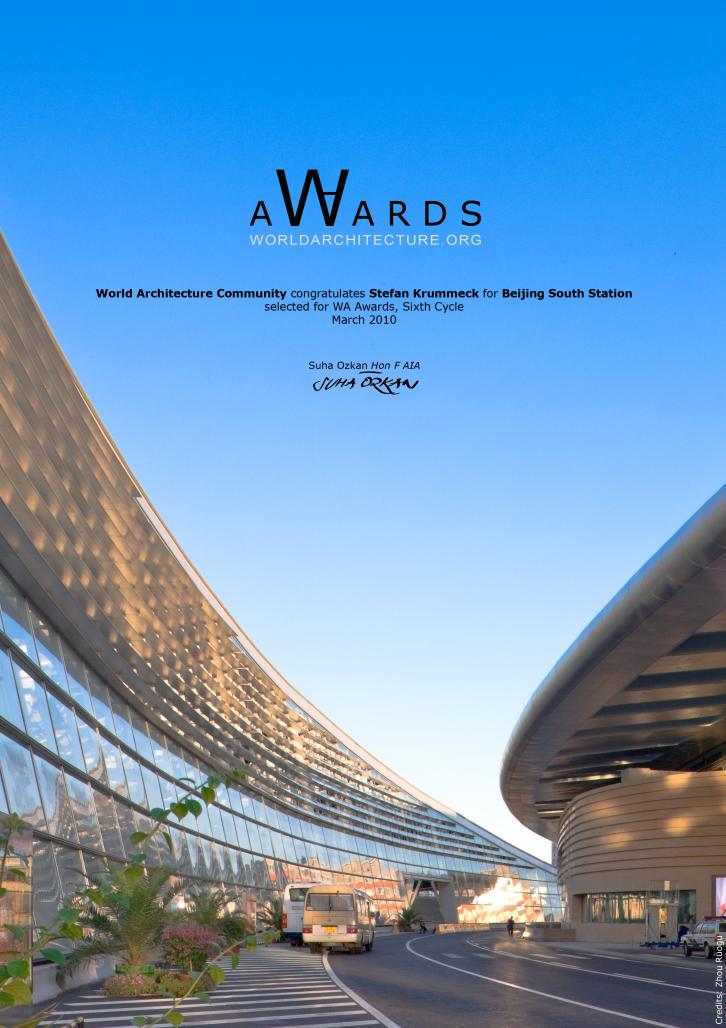The Beijing South Station is not only a key rail link for China’s new high-speed intercity network but it is also a major urban building and master plan. Situated on a 31 hectare site the Station creates an urban link with the surrounding cityscape and acts as a “Gateway to the City” whilst the station itself is designed for a passenger turnover of 105 million passengers annually by the year 2030, with a peak hour flow of 33,280 passengers per hour, and a total of 286,500 passenger movements per day. This integrated design encompasses a multi-modal transport interchange facility with a vertical separation strategy designed so that the passenger traffic flows are direct, convenient and highly efficient.
Completed in 2008 the new station is one of four major rail stations for the new high-speed rail implemented within China and was a core Olympic project endorsed by the Beijing Government and a critical part of Beijing South Railway Station upgrading and extension project.
Situated half a kilometre from the citys old station in Fengtai district between the second and third ring roads, the new Beijing Station will serve as a high-speed intercity rail link which connects Beijing with the Yangtze River Delta cities of Tianjin and Shanghai, with a catchment area of 270 million people.
As the station is immense in scale, the architectural form and structure are clear, simple and people oriented and take into consideration the different operational and management of the various rail lines, station entrances, exits, waiting areas and interchange zones taking place within – the station takes a simple ellipse form that accommodates 3 principle floor levels with two basement floor levels for Metro and two ancillary gateway office buildings. With such large volumes of passengers it is essential to separate the incoming and departing passengers. One of the main design objectives was to have the passengers board and alight trains with the shortest distance and time possible.
The design strategy also incorporates separate zones catering for seamless integration and transition to different types of vehicular traffic including 909 underground basement car-parking spaces, 28 taxi drop-off bays, 24 taxi pick-up bays with 138 queuing spaces and 38 bus spaces (12 drop-off spaces and 26 pick-up bays with 48 queuing spaces) as a comprehensive transport hub. The elliptical plan form is effective in providing an innovative solution to the station’s vehicular traffic flow. The overhead road network can adjust to the traffic flows to and from the station area in all directions and assist in relieving the congestion of the surrounding urban arterial roads.
There are a total of 11 island platforms and 2 side platforms with 24 platform edges for High-speed trains (450 metres long), Express trains (500 metres long) and Intercity trains (450 metres long); with 2 island platforms with 4 platform edges for the Metro trains(120 metres long).
As the station is located on existing railway land, the geometry of the site juxtaposes the diagonal fan of the railway tracks to Beijing’s cardinal urban grid. The station scheme creates an urban link with the surrounding cityscape and acts as a “Gateway to the City” with the incorporation of an urban response that unites the railway fan and city grid by inserting a landscaped pedestrian spine in the formal north-south axis that maximizes the sense of approach and creates enhanced public amenity spaces with the public parks and the wider city context.
2003
2008
Beijing South Station by Stefan Krummeck in China won the WA Award Cycle 6. Please find below the WA Award poster for this project.

Downloaded 751 times.
.jpg)

.jpg)




.jpg)
.jpg)
